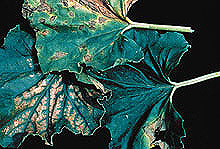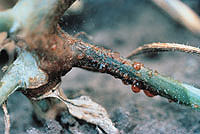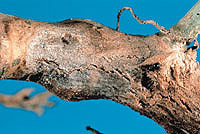|

Fig. 1. Foliar symptoms of gummy stem
blight of melon, caused by Didymella
bryoniae (anamorph Phoma
cucurbitacearum). Courtesy T. A. Zitter.
(Click image for larger view).
|
|
Contributed by
W. R. Sitterly
and
A. P. Keinath
Clemson University
Coastal R&E Center
Charleston, SC 29414-5332
Gummy stem blight was first reported in 1891 in France, Italy, and the United States. It affects the leaves, stems, and fruits of all cucurbits. On fruit the disease is known as black rot. The disease has become increasingly severe as fungicide usage and genetic resistance have resulted in the effective control of other cucurbit diseases. The pathogen is most common in the southern United States and in subtropical and tropical areas of the world. It is also found in temperate regions, especially on winter squash and pumpkin, and on greenhouse-grown cucumber.
Symptoms
Circular, tan to dark brown spots appear on the leaves, often first at the margins, and enlarge rapidly until the entire leaf is blighted (Fig. 1). Circular, black or tan spots appear on the cotyledons and stems of young plants. Water-soaking may occur on hypocotyls and leaves. Stem cankers develop in the cortical tissue, and a brown, gummy exudate is commonly produced on the surface (Fig. 2). Small fruiting bodies (pycnidia or perithecia) may appear as black specks on the cankers (Fig. 3). (See Compendium of Cucurbit Diseases, Table 7 and Part V, Fig. 14.) Stems may be girdled and seedlings killed.
 |
|
 |
| Fig 2. Stem canker. Courtesy B. D. Bruton. (Click image for larger view). |
|
Fig. 3. Pycnidia of P. cucurbitacearum. Courtesy T. A. Zitter. (Click image for larger view). |
If infection occurs in older plants, lesions develop more slowly on stems near the center of a hill. Cankered vines usually wilt after mid-season. Small, water-soaked spots develop on infected fruit, enlarge to indefinite size, and exude gummy material. The spots contain conspicuous black fruiting bodies.
In the tropics infection can occur through fresh blossom scars and is manifested as a rapid decay of inner fruit tissue, which proceeds from the blossom end to the stem end and then moves to the fruit surface.
Causal Organism
Gummy stem blight is caused by Didymella bryoniae (Auersw.) Rehm (syn. Mycosphaerella melonis (Pass.) Chiu & J. C. Walker). Dark pycnidia of the anamorph, Phoma cucurbitacearum (Fr.:Fr.) Sacc. (syn. Ascochyta cucumis Fautrey & Roum.), 120–180 µm in diameter, form on the surface of leaves, stems, and fruits. The conidia are hyaline, cylindrical with rounded ends, non- or monoseptate, and 6–13 µm long. Dark pseudothecia, 125–213 µm in diameter, may also form, especially on stems. The numerous bitunicate asci usually produce eight ascospores per ascus. The ascospores are 14–18 × 4–6 µm, hyaline, monoseptate with a constriction at the septum, and rounded on the ends. The upper cell is usually wider than the lower cell. No physiological specialization has been reported. The fungus grows in culture between 12 and 32°C, with an optimum temperature of 24°C.
Disease Cycle
The pathogen survives between seasons on diseased vines and crop debris and may be seedborne. The optimum temperature for infection is 20°C in melon and 24–25°C in watermelon and cucumber. Moisture is more important for disease development than temperature. Peak ascospore dispersal occurs after rain and during dew periods at night. Free moisture on leaves for at least 1 hr is necessary for infection, and further continuous leaf wetness is required for lesion expansion. Leaves are penetrated either directly through the cuticle or through intercellular spaces around the bases of trichomes. Stems are penetrated through wounds or by the extension of leaf lesions. Fruits are penetrated either through wounds or through flower scars at the time of pollination. Fruit rot begins to develop about 3 days after infection. Cotyledons and young leaves of watermelon and melon are very susceptible, but those of cucumber and certain squash are resistant and become susceptible only as they mature.
Control
The use of treated seed should be a standard procedure, and a 2-year rotation cycle is essential. Although plant breeders have identified resistance genes in several cucurbits, no commercially acceptable resistant cultivars of watermelon, melon, or cucumber have been developed.
Satisfactory chemical control may be obtained by regular applications of protectant fungicides. Isolates of D. bryoniae resistant to benzimidazole fungicides have been detected in greenhouse cucumber culture in Greece and the Netherlands and recently in cucurbit fields in the eastern United States.
In addition to fungicide sprays, greenhouse ventilation and irrigation should be managed to minimize free moisture on leaf surfaces.
Selected References
Chiu, W. F., and Walker, J. C. 1949. Physiology and pathogenicity of the cucurbit black rot fungus. J. Agric. Res. 78:589-615.
Keinath, A. P., Farnham, M. W., and Zitter, T. A. 1995. Morphological, pathological, and genetic differentiation of Didymella bryoniae and Phoma spp. isolated from cucurbits. Phytopathology 85:364-369.
Keinath, A. P., and Zitter, T. A. 1995. First report of benomyl-insensitive Didymella bryoniae in the United States. (Abstr.) Phytopathology 85:1126.
Malathrakis, N. E., and Vakalounakis, D. J. 1983. Resistance to benzimidazole fungicides in the gummy stem blight pathogen Didymella bryoniae in cucurbits. Plant Pathol. 32:395-399.
Schenck, N. C. 1968. Incidence of airborne fungus spores over watermelon fields in Florida. Phytopathology 58:91-94.
Van Steekelenburg, N. A. M. 1985. Influence of humidity on incidence of Didymella bryoniae on cucumber leaves and growing tips under controlled environmental conditions. Neth. J. Plant Pathol. 91:277-283.
RETURN TO APSnet FEATURE STORY
